Abstract
A five-level atomic system is proposed in vicinity of a two-dimensional (2D) plasmonic nanostructure with application in atom-photon entanglement. The behavior of the atom-photon entanglement is discussed with and without a control laser field. The amount of atom-photon entanglement is controlled by the quantum interference created by the plasmonic nanostructure. Thus, the degree of atom-photon entanglement is affected by the atomic distance from the plasmonic nanostructure. In the presence of a control field, maximum entanglement between the atom and its spontaneous emission field is observed.
Subject terms: Quantum information, Quantum optics
Introduction
The light-matter coherent interaction leads to an important phenomenon in quantum science such as quantum entanglement1,2. Quantum entanglement has widely been proposed due to its applications in quantum computing and quantum information technology3,4. Some important applications of entangled particles are their use in quantum algorithms5, quantum cryptography6, quantum networks7,8, and teleportation9. In last two decades, different approaches were presented to generate entangled particles10,11. Lately, matter-field entanglement has reached specific regard, because photons are used to carry the quantum information, and atoms are used to store it12. Many proposals were presented to produce the entanglement between quantum systems and their spontaneous emission field. Some of these articles are including the generation of entanglement between the atom and its spontaneous emission field via quantum entropy under the EIT conditions13–15. Time dependent behavior of the atom-photon entanglement is discussed when a four-level atom is embedded near the band edge of a photonic crystal16. The time evolution of the quantum entropy in a triple quantum dot molecule is controlled by the gate voltage and the rate of an incoherent pump field17. It was also shown that atom-photon entanglement can be controlled by the relative phase of the applied fields18, and the quantum interference parameter19,20. Basically, atom-photon entanglement can be achieved by the atomic coherence that is created by the coherent laser fields. Instead, when the system interacts with the surrounding reservoirs, due to the decoherence processes, the degree of entanglement and the information degrades. Spontaneous emission is an important phenomenon that leads to disentanglement of the two entangled states. However, spontaneous emission is an incoherent process, which can be controlled by placing the emitters in frequency-dependent reservoirs21, near the edges of photonic bandgaps (PBG)22,23, or in a microwave cavity24. The spectrum of the spontaneous emission strongly depends on the energy levels structure and the generated quantum coherence25. Therefore, due to quantum interference mechanism, the rate of spontaneous emission may be decreased or even suppressed.
On the other hand, the optical properties of the quantum emitters, i.e. atoms or semiconductor quantum dots, can significantly be modified when quantum systems are placed near the plasmonic nanostructures26. In vicinity of plasmonic nanostructures, the strong interaction between the electromagnetic field and the quantum emitters can be occurred27. Therefore, the optical response of the quantum emitter can be controlled using a hybrid quantum-plasmonic system. Quenching or enhancement of the spontaneous emission28–30, gain without population inversion31, enhancement of nonlinear optical response32–34 are described in hybrid plasmonic nanostructure. The effect of plasmonic nanostructure on optical grating35, probe field absorption36, and slow-light propagation37 was also proposed.
Now, we study the entanglement of a five-level quantum emitter coupled to a plasmonic nanostructure, namely a periodic 2D array of metal-coated dielectric nanospheres, and its spontaneous emission field. The combined density matrix approach and ab initio electromagnetic calculations are employed to discuss the response of the system. Steady-state population distribution of the various levels of the quantum emitter with and without the control laser field are investigated. We show that the population distribution and consequently atom-photon entanglement is strongly affected by the distance of quantum emitter from the plasmonic nanostructure. We show that the maximum value of entanglement can be achieved at a certain distance from the plasmonic nanostructure. We also prove that the degree of entanglement can effectively be controlled by the quantum interference between decay processes due to the proximity of the plasmonic nanostructure.
In the following discussion; we first present the coherently driven atomic model. Then, we obtain the relevant density matrix equations in the presence of the plasmonic nanostructure, and present the reduced entropy for calculating the atom-photon entanglement. In “Results and discussions” section some numerical results of the atom-photon entanglement are presented. Finally, the paper is concluded in “Conclusion” section.
Model and equations
Consider a five-level atomic system with two lower levels and , two closely lying middle Zeeman sublevels and , and an additional higher-level as depicted in Fig. 1. Assume this atomic system is fixed at a distance from the plasmonic nanostructure’s surface, which is located in vacuum space (Fig. 2). The strength of the interaction between the atom and nearly-resonant optical electric field is characterized by the dipole moment operator . Hamiltonian for this interaction is . The diagonal matrix elements of this operator determine the dipole moments of the electron in the states , and are non-zero only in atoms with permanent dipole moments. The off-diagonal matrix elements are transition dipole moment, which demonstrates the transition of an electron from the state to the state and vice versa. The matrix elements can be real or complex and . We take , and . The diagonal matrix elements , and are assumed to be real. The electric dipole moment operator is written as
| 1 |
where and describe the right- and left-rotating unit vectors, which are defined as
| 2 |
Figure 1.
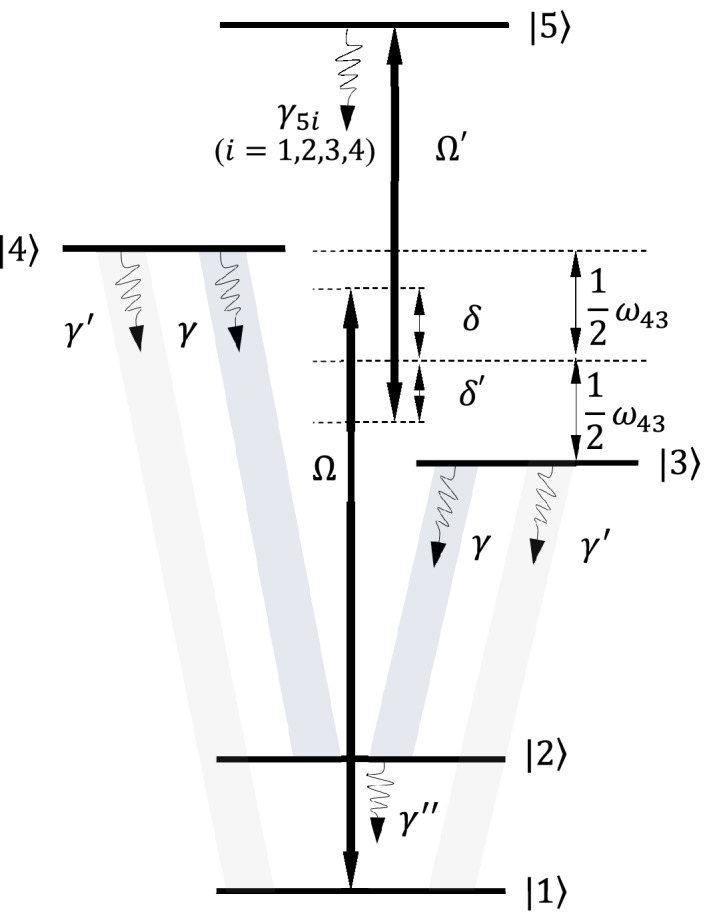
Energy diagram of a five-level atomic system.
Figure 2.

A 2D array of plasmonic nanostructures used in this study.
Here, and are unit vectors in and directions. Two linearly polarized continuous electric fields as and are applied to the quantum system, where () and () are the amplitude and angular frequency of the electric field, respectively. The electric field drives transition (), while controlling electric field couples level to Zeeman sublevels and . The atom–field interaction in dipole and rotating-wave approximation is described by Hamiltonian
| 3 |
Here, ( is the detuning between respected energy levels and applied fields, which is measured from average transition frequencies of level and level with level (). So, detunings define as , and , where, are transition frequencies between the energy level and level . The parameters and are the corresponding Rabi-frequencies.
The spontaneous emission rates from the excited level to the other lower levels are denoted by (). The transitions from level to level and level are influenced by the interaction of the quantum system with free-space vacuum modes, so these transitions are not affected by the plasmonic nanostructure. The Zeeman sublevels and spontaneously decay to level () with decay rates () and (), respectively. Moreover, we assume the transitions from level and level to level spectrally be located in the surface-plasmon band of the plasmonic nanostructure, while the transitions from level and level to level are also far from the surface-plasmon bands.
Note that, if we consider the transitions from level and level to level near the surface plasmon band of the plasmonic nanostructure, the Rabi frequency of the coupling light, which couples the ground level to upper-intermediate states, may be affected by plasmonic nanostructure. In fact, the plasmonic nanostructure affects the Rabi frequency of coupling light, and its value may be changed.
For simplicity, we assume to be relatively small that equals to a few (decay rate of level and level to level in the vacuum). Later, the energy of both middle levels is taken to be the same; thus decay rates from level and level to level are coupled by the same vacuum mods. Therefore, these transitions are free-space spontaneous decay. In addition, spontaneous decay from level and level to level are coupled by the same mods that affected by plasmonic nanostructure. Then, we can assume and 38.
Considering the Hamiltonian described in Eq. (3), the density matrix equations of motion in rotating frame are obtained by quantum Liouville equation
| 4 |
where is Liouville operator and expresses the dissipation processes which is given by
| 5 |
where, is the atom transition operator (see Eq. 1 in Supplementary Note). represents the coupling coefficient between level and level . This coefficient is due to anisotropic vacuum influence on spontaneous emission due to the existence of plasmonic nanostructure (anisotropic Purcell effect)39, which arises due to the quantum interference mechanism40. The values of and can be obtained by the dyadic electromagnetic Green’s tensor 41, as
| 6a |
| 6b |
where , displays the position of the atomic system, and refers to the permeability of vacuum space. Due to the Eq. (5), we can write the values of and 42, as
| 7a |
| 7b |
Moreover, , indicates the elements of the electromagnetic wave Green’s tensor. Here, index () denotes the dipole oriented parallel (normal) along the x-axis (z-axis) to the surface of the plasmonic nanostructure38. Therefore, we express the spontaneous emission rates in parallel and normal directions to the surface of the plasmonic nanostructure as
| 8a |
| 8b |
Now, we introduce the quantum interference parameter as that arises due to existence of plasmonic nanostructure. Spontaneous emission may be enhanced or even quenched via the quantum interfere mechanism depending on and . When quantum system is very far from the plasmonic nanostructure, i.e. and , no quantum interference appears37,43,44. However, if the emitter is placed near the plasmonic nanostructure, i.e. , the parameter is identical and quantum interference is maximum.
Here, we propose a 2D array of plasmonic nanostructures, where metal-coated silica nanospheres are connected to each other (Fig. 2). The shell has a frequency-dependent dielectric function represented by a Drude-model electric permittivity
| 9 |
where demonstrates the relaxation time for electrons of metal conduction-band, and represents the plasma frequency of the bulk. The plasma frequency for silver metal is . Also, this value specifies the length order of the system as . For the dielectric constant is . In the calculation process, we assume . This square lattice has a lattice constant and radius of the sphere (core) ()27.
Now, we consider a model with two subsystems such as atom () and its spontaneous emission photon (). If this atom–field pure state system cannot be expressed as a tensor product of the two subsystems (), the atom and its spontaneous emission photon will be entangled. We utilize the reduced quantum entropy to measure the amount of atom-photon entanglement. To measure the degree of entanglement of a pure state , we only need the atomic quantum entropy 45,46. The reduced quantum entropy for the bipartite pure system is the von-Neumann reduced entropy as defined
| 10 |
We can also represent the atomic quantum entropy according to terms eigenvalues of reduced density operators as a degree of entanglement ()
| 11 |
where are the eigenvalues of the . To achieve a quantum pure state, we assume all the atoms initially in their ground states (). If this reduced density matrix, , describes a (maximally) mixed subsystem, then the whole pure state , will be (maximally) entangled. When entropy of entanglement is equal to , we will have a maximally entangled state. In addition, the amount of the entropy is limited by the , where is the dimension of a Hilbert space . The entropy is maximized when the quantum state is maximally mixed, i.e. , where is an identity matrix47. Therefore, by evenly distributed population on the atomic levels, we will have the maximum amount of entanglement. Hence, the rate of spontaneous emission affects the population distribution leading to change of the atom-photon entanglement.
Results and discussions
Now, density matrix equations (4) along with Eq. (11) should numerically be solved to reach the . In this regard, relates to the atomic parameters given in supplementary Eq. (1), and will characterize the degree of atom-photon entanglement. In following discussion, all the parameters are scaled by the parameter that is the decay rate of spontaneous emission in free space. The decay rates from level to level () are defiend as and . The transitions from level and level to level and from level to level are the dipole-allowed spontaneous decay rates that are equal to and , respectively. For transitions from level and level to level , the dipole-allowed spontaneous decay rates are equal to . The parameters and are obtained according to Eq. (8) in terms of and for the distances expressed in Table 1. Note that the values for the controlling parameters are chosen according to the 87Rb atom as a areal atomic system. In fact, the proposed five-level quantum system can be realized in hyperfine sublevels of 87Rb. Thus the proposed levels are labeled by the spectroscopic definition as , , , , and . In this regards transition is corresponding to the line of 87Rb48–51.
Table 1.
The values of and according to distances of the atom from the plasmonic nanostructure for ().
| Distance | 10.4 | 20.8 | 31.2 | 41.6 | 52 | ∞ |
|---|---|---|---|---|---|---|
| ( | 27.081 | 6.417 | 1.774 | 0.559 | 0.196 | 1 |
| ( | 0.105 | 0.038 | 0.021 | 0.021 | 0.026 | 1 |
| 13.958 | 3.228 | 0.898 | 0.290 | 0.111 | 1 | |
| 13.853 | 3.190 | 0.877 | 0.269 | 0.085 | 0 | |
| 0.993 | 0.988 | 0.977 | 0.928 | 0.766 | 0 |
Here, we are interested in studying the steady-state and dynamical behavior of the atom-photon entanglement under the condition . Note that maximum value of the entanglement for the N-levels atomic system is , where we use the concept of normalized entanglement as a ratio of per . Here, represents variables such as Rabi-frequencies and quantum interference that may change the . Hence, the amount of normalized entanglement of any N-level atomic system can be expressed as . For the proposed five-level quantum system, the maximum value of expected entanglement must be , where its normalized value is .
Figure 3, displays the time-dependent normalized behavior of in the absence of plasmonic nanostructure, i.e. , where and . The atoms initially are in their ground state, and , thus the whole system is in a pure state. Therefore, the atom and its spontaneous emission field is initially disentangled. By increasing the normalized time, the two subsystems including the atom and photon reache to a mixed state, and the increases by the time. In the absence of the control field, i.e. , the five-level atomic system converts to a four-level one. Without the control field (Fig. 3a), the reaches to , while it increases to for (Fig. 3b). So, in the presence of control field, the is higher than the case without control field. This is due to the existence of spontaneous emission from upper level to lover levels leading to equally population distribution of each levels.
Figure 3.

The time evolution of normalized () of the quantum system in the absence of plasmonic nanostructure for (a) , and (b) .
The steady-state behavior of the normalized as a function of the Rabi-frequency without plasmonic nanostructure is displayed in Fig. 4. The results are in a good agreement with Fig. 3.
Figure 4.
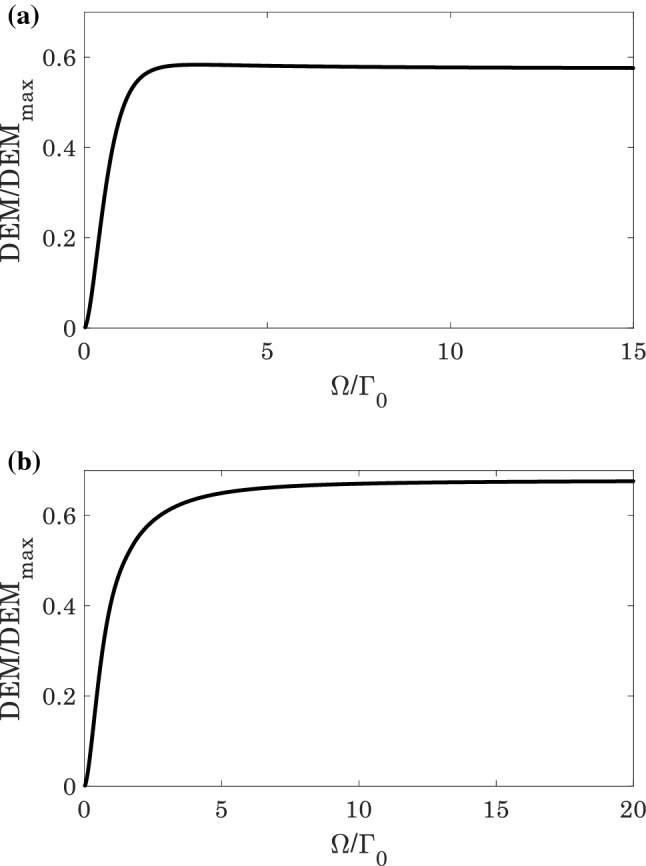
The normalized () of the quantum system in the absence of plasmonic nanostructure for (a) , and (b) .
In Fig. 5, the time evolution of normalized is presented in the presence of plasmonic nanostructure with and without control field. Similarly, the atom and its spontaneous emission field are initially disentangled, but by increasing the normalized time the also increases. In vicinity of nanostructure, the atom and its spontaneous emission field undergoes different degrees of entanglement depending on the distance of atom from the plasmonic nanostructure. We find that for both cases and , by increasing the distance of atom from the plasmonic nanostructure, the atom-photon entanglement increases (Fig. 5). Similar to Fig. 3, for the is higher than . But in the amount of for is about , while it reaches to for . This is the optimal normalized entanglement. Note that the quantum interference arising from the existence of plasmonic nanostructure has crucial role in atom-photon entanglement. By increasing the distance of the emitter from the plasmonic nanostructure, quantum interference reduces as can be seen from table (1). Thus, the spontaneous emission from level and level to level can be controlled by the quantum interference that depends on the distance of atom from the nanostructure. Then, will change just by the spontaneous emission of level and level to level , where it controls by the quantum interference.
Figure 5.

The time evolution of normalized () of the quantum system in the presence of plasmonic nanostructure for (a) , and (b) .
The normalized as a function of the Rabi-frequency for various distances is denoted in Fig. 6. It is obviously realized that by increasing the distance of atom from the plasmonic nanostructure, the atom-photon entanglement increases. These results are confirmed by Fig. 5, and we concluded that the amount of atom-photon entanglement in vicinity of the plasmonic nanostructure can be controlled just by the distance .
Figure 6.
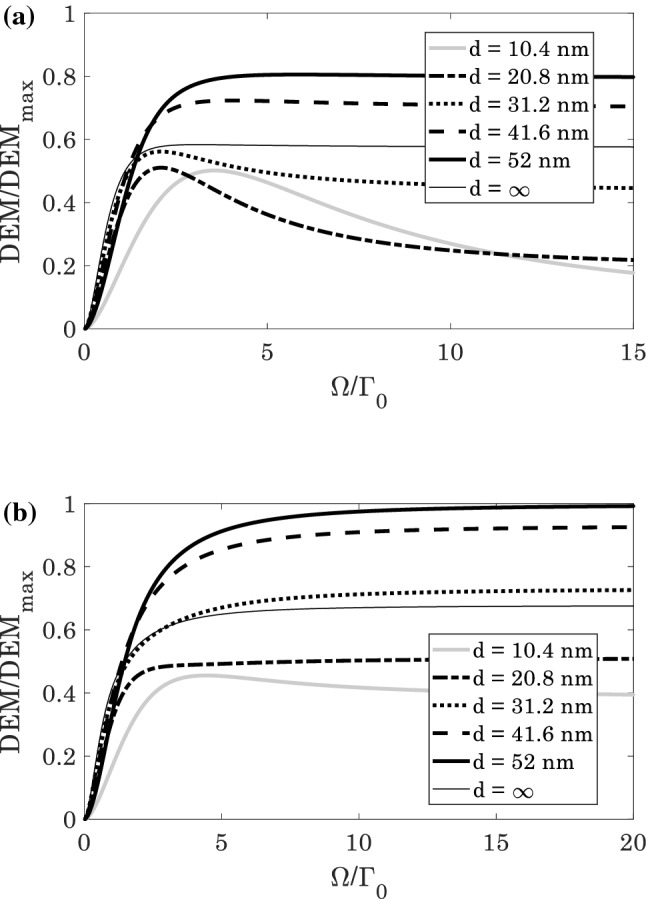
The normalized () of the quantum system in the presence of plasmonic nanostructure for (a) , and (b) .
In order to discuss the physical mechanism of the obtained results, the population distribution of the bare and dressed states is analyzed in the following discussion.
Figure 7 shows the population distribution of the bare states. We observe that the population is not equally distributed among the bare states, and this may reduce the (Fig. 7a). However, when the population is equally distributed among the bare states, the maximum atom-photon entanglement is observed. Thus the obtained results in previous figures are approved by the population distribution.
Figure 7.
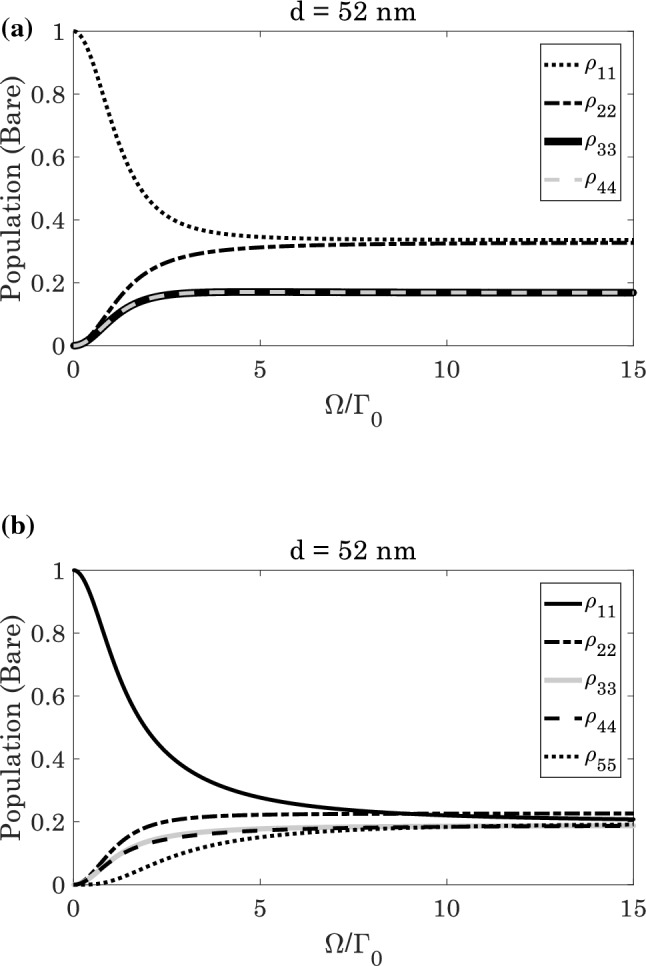
The population distribution of the bare states as a function of Rabi-frequencies at for (a) , and (b) .
To give more physical insight on the maximal atom-photon entanglement, the dressed state formalism is also presented. Without the control field, i.e. , the transformed Hamiltonian can be written as
| 12 |
By calculating the eigenvalues of this Hamiltonian, using the relation , we obtain
| 13 |
where ’s are eigenvalues of this Hamiltonian operator. For , the eigenvalue ’s are given by
| 14 |
where called generalized Rabi-frequency. So, the corresponding dressed states are
| 15 |
When the control field is on, transformed Hamiltonian are written as
| 16 |
Thus, using the relation , we can reach to
| 17 |
For , eigenvalues ’s are obtained as follows
| 18 |
where, generalized Rabi-frequency is . So, the corresponding dressed states are
| 19 |
Figure 8 demonstrates the evolution of dressed state’s population. According to 8(a), the dressed state has no population distribution, and the population are equally distributed in other three dressed states. In this case, the system operates as a three-level dressed atom, and the maximum value of normalized should be . This anticipation is in a good agreement of obtained results in Figs. 5a and 6a. In Fig. 8b, all the levels are populated, and the population distributed are almost equal in five dressed states. In this regards, the system acts as a five-level atom, and the maximum value of normalized should be equal to . This is also covering the obtained result of Figs. 5b and 6b.
Figure 8.
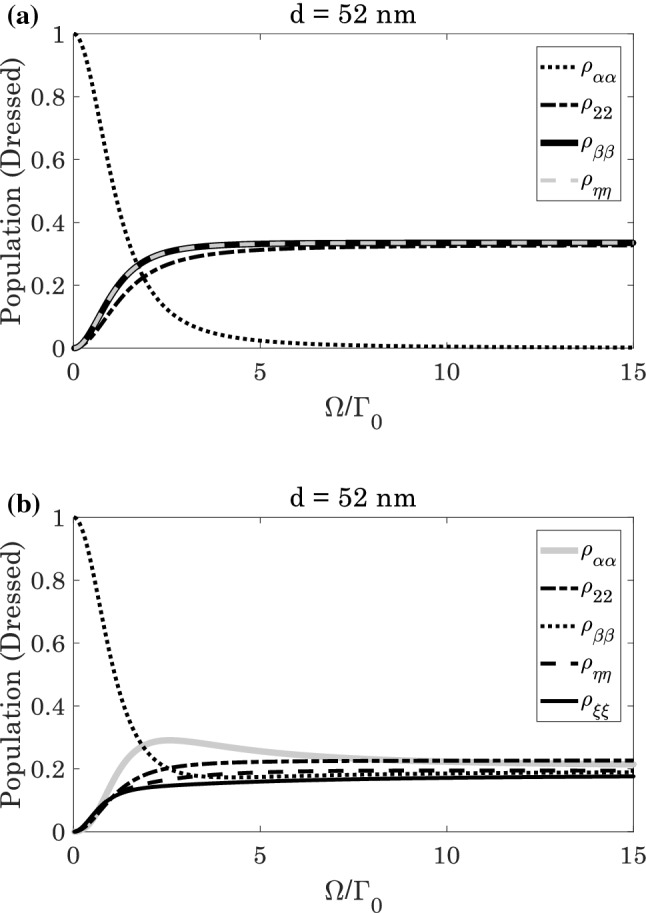
The dressed state population distribution as a function of Rabi-frequencies at distance for (a) , and (b) .
Physically, existence of plasmonic nanostructure affects the transition () that appears in parameter . In fact, the five-level atomic system has two -type transitions , and (). The second transitions are coupled due to existence of plasmonic nanostructure that creates the parameter . These transitions may destroy the equality of the population distribution that leads in reduction of atom-photon entanglement as can be viewed in Figs. 7a and 8a. However, this may be balanced by the other laser field namely as can be confirmed in Figs. 7b and 8b.
Conclusion
The entanglement of a five-level atomic system and its spontaneous emission field is investigated with and without plasmonic nanostructure. For two linear laser fields, two different cases are examined. For turn off control laser field, the five-level system converts to a four-level one. In free space, the degree of created entanglement in five-level atomic system with its spontaneous emission is larger than the four-level atom. In the vicinity of the nanostructure, the atom-photon entanglement is affected by the distances of the atomic system from plasmonic nanostructure. The degree of entanglement depends on the distance of atom and the plasmonic nanostructure. Maximal atom-photon entanglement is obtained for a distance of from the nanostructure. Because no coupling field drives the level , the only way to populate this level is spontaneously emitted photons from higher levels. Then, we are able to control the quantum interference using plasmonic nanostructure and therefore can control the spontaneous emission from level and level to level . By controlling the amount of population of level , we will be able to control the amount of normalized entanglement.
Supplementary Information
Author contributions
S.H.A. and M.S. proposed the idea, B.S. obtained the figures and wrote the main manuscript text. All authors reviewed the manuscript.
Competing interests
The authors declare no competing interests.
Footnotes
Publisher's note
Springer Nature remains neutral with regard to jurisdictional claims in published maps and institutional affiliations.
Supplementary Information
The online version contains supplementary material available at 10.1038/s41598-021-04641-6.
References
- 1.Paternostro M, Kim MS, Ham BS. Generation of entangled coherent states via cross-phase-modulation in a double electromagnetically induced transparency regime. Phys. Rev. A. 2003;67:23811. [Google Scholar]
- 2.Marino AM, Pooser RC, Boyer V, Lett PD. Tunable delay of Einstein–Podolsky–Rosen entanglement. Nature. 2009;457:859–862. doi: 10.1038/nature07751. [DOI] [PubMed] [Google Scholar]
- 3.Ekert A, Jozsa R. Quantum algorithms: Entanglement–enhanced information processing. Philos. Trans. R. Soc. Lond. Ser. A Math. Phys. Eng. Sci. 1998;356:1769–1782. [Google Scholar]
- 4.Azuma H, Bose S, Vedral V. Entangling capacity of global phases and implications for the Deutsch-Jozsa algorithm. Phys. Rev. A. 2001;64:62308. [Google Scholar]
- 5.Briegel H-J, Dür W, Cirac JI, Zoller P. Quantum repeaters: The role of imperfect local operations in quantum communication. Phys. Rev. Lett. 1998;81:5932–5935. [Google Scholar]
- 6.Jennewein T, Simon C, Weihs G, Weinfurter H, Zeilinger A. Quantum cryptography with entangled photons. Phys. Rev. Lett. 2000;84:4729. doi: 10.1103/PhysRevLett.84.4729. [DOI] [PubMed] [Google Scholar]
- 7.Kimble HJ. The quantum internet. Nature. 2008;453:1023–1030. doi: 10.1038/nature07127. [DOI] [PubMed] [Google Scholar]
- 8.Cirac JI, Zoller P, Kimble HJ, Mabuchi H. Quantum state transfer and entanglement distribution among distant nodes in a quantum network. Phys. Rev. Lett. 1997;78:3221–3224. [Google Scholar]
- 9.Bouwmeester D, et al. Experimental quantum teleportation. Nature. 1997;390:575–579. [Google Scholar]
- 10.Ma YH, Mu QX, Zhou L. Entangled photons produced by a three-level atom in free-space. Opt. Commun. 2008;281:2695–2699. [Google Scholar]
- 11.Amniat-Talab M, Guérin S, Sangouard N, Jauslin H-R. Atom-photon, atom-atom, and photon-photon entanglement preparation by fractional adiabatic passage. Phys. Rev. A. 2005;71:23805. [Google Scholar]
- 12.Stute A, et al. Tunable ion–photon entanglement in an optical cavity. Nature. 2012;485:482–485. doi: 10.1038/nature11120. [DOI] [PMC free article] [PubMed] [Google Scholar]
- 13.Kuang L-M, Zhou L. Generation of atom-photon entangled states in atomic Bose-Einstein condensate via electromagnetically induced transparency. Phys. Rev. A. 2003;68:43606. [Google Scholar]
- 14.Kordi Z, Ghanbari S, Mahmoudi M. Atom–photon entanglement beyond the multi-photon resonance condition. Quantum Inf. Process. 2016;15:199–213. [Google Scholar]
- 15.Fang M-F, Zhu S-Y. Entanglement between a Λ-type three-level atom and its spontaneous emission fields. Phys. A Stat. Mech. Appl. 2006;369:475–483. [Google Scholar]
- 16.Sahrai M, Boroojerdi VTA. Dynamical behavior of atom–photon entanglement for a four-level atom near the band edge of a 3D-anisotropic photonic crystal. Quantum Inf. Process. 2017;16:145. [Google Scholar]
- 17.Sahrai M, Arzhang B, Taherkhani D, Boroojerdi VTA. Control of the entanglement between triple quantum dot molecule and its spontaneous emission fields via quantum entropy. Phys. E Low-Dimens. Syst. Nanostruct. 2015;67:121–127. [Google Scholar]
- 18.Kordi Z, Ghanbari S, Mahmoudi M. Maximal atom–photon entanglement in a double-Λ quantum system. Quantum Inf. Process. 2015;14:1907–1918. [Google Scholar]
- 19.Tang Z, Li G, Ficek Z. Entanglement created by spontaneously generated coherence. Phys. Rev. A. 2010;82:063837. [Google Scholar]
- 20.Abazari M, Mortezapour A, Mahmoudi M, Sahrai M. Phase-controlled atom-photon entanglement in a three-level V-type atomic system via spontaneously generated coherence. Entropy. 2011;13:1541–1554. [Google Scholar]
- 21.Lewenstein M, Zakrzewski J, Mossberg TW. Spontaneous emission of atoms coupled to frequency-dependent reservoirs. Phys. Rev. A. 1988;38:808. doi: 10.1103/physreva.38.808. [DOI] [PubMed] [Google Scholar]
- 22.Zhu S-Y, Chen H, Huang H. Quantum interference effects in spontaneous emission from an atom embedded in a photonic band gap structure. Phys. Rev. Lett. 1997;79:205. [Google Scholar]
- 23.Zhang HZ, Tang SH, Dong P, He J. Quantum interference in spontaneous emission of an atom embedded in a double-band photonic crystal. Phys. Rev. A. 2002;65:63802. [Google Scholar]
- 24.Garraway BM, Knight PL. Cavity modified quantum beats. Phys. Rev. A. 1996;54:3592. doi: 10.1103/physreva.54.3592. [DOI] [PubMed] [Google Scholar]
- 25.Zhu S-Y, Narducci LM, Scully MO. Quantum-mechanical interference effects in the spontaneous-emission spectrum of a driven atom. Phys. Rev. A. 1995;52:4791. doi: 10.1103/physreva.52.4791. [DOI] [PubMed] [Google Scholar]
- 26.Tame MS, et al. Quantum plasmonics. Nat. Phys. 2013;9:329–340. [Google Scholar]
- 27.Paspalakis, E., Kallos, E. & Yannopapas, V. Controlled interaction of a four-level quantum emitter with a plasmonic nanostructure. In Journal of Physics: Conference Series Vol. 633, 12063 (IOP Publishing, 2015).
- 28.Kühn S, Mori G, Agio M, Sandoghdar V. Modification of single molecule fluorescence close to a nanostructure: Radiation pattern, spontaneous emission and quenching. Mol. Phys. 2008;106:893–908. [Google Scholar]
- 29.Yannopapas V, Vitanov NV. Spontaneous emission of a two-level atom placed within clusters of metallic nanoparticles. J. Phys. Condens. Matter. 2007;19:96210. [Google Scholar]
- 30.Gu Y, Huang L, Martin OJF, Gong Q. Resonance fluorescence of single molecules assisted by a plasmonic structure. Phys. Rev. B. 2010;81:193103. [Google Scholar]
- 31.Sadeghi SM. Gain without inversion in hybrid quantum dot–metallic nanoparticle systems. Nanotechnology. 2010;21:455401. doi: 10.1088/0957-4484/21/45/455401. [DOI] [PubMed] [Google Scholar]
- 32.Hamedi, H. R., Yannopapas, V. & Paspalakis, E. Control of nonlinear optical phenomena and spatially structured optical effects in a four-level quantum system near a plasmonic nanostructure (2020).
- 33.Yannopapas V. Enhancement of nonlinear susceptibilities near plasmonic metamaterials. Opt. Commun. 2010;283:1647–1649. [Google Scholar]
- 34.Pu Y, Grange R, Hsieh C-L, Psaltis D. Nonlinear optical properties of core-shell nanocavities for enhanced second-harmonic generation. Phys. Rev. Lett. 2010;104:207402. doi: 10.1103/PhysRevLett.104.207402. [DOI] [PubMed] [Google Scholar]
- 35.Vafafard A, Sahrai M, Siahpoush V, Hamedi HR, Asadpour SH. Optically induced diffraction gratings based on periodic modulation of linear and nonlinear effects for atom-light coupling quantum systems near plasmonic nanostructures. Sci. Rep. 2020;10:16684. doi: 10.1038/s41598-020-73587-y. [DOI] [PMC free article] [PubMed] [Google Scholar]
- 36.Carreño F, Antón MA, Yannopapas V, Paspalakis E. Control of the absorption of a four-level quantum system near a plasmonic nanostructure. Phys. Rev. B. 2017;95:195410. [Google Scholar]
- 37.Evangelou S, Yannopapas V, Paspalakis E. Transparency and slow light in a four-level quantum system near a plasmonic nanostructure. Phys. Rev. A. 2012;86:053811. [Google Scholar]
- 38.Evangelou S, Yannopapas V, Paspalakis E. Modifying free-space spontaneous emission near a plasmonic nanostructure. Phys. Rev. A. 2011;83:023819. [Google Scholar]
- 39.Agarwal GS. Anisotropic vacuum-induced interference in decay channels. Phys. Rev. Lett. 2000;84:5500–5503. doi: 10.1103/PhysRevLett.84.5500. [DOI] [PubMed] [Google Scholar]
- 40.Kiffner, M., Macovei, M., Evers, J. & Keitel, C. H. Vacuum-Induced Processes in Multilevel Atoms 85–197 (2010) 10.1016/B978-0-444-53705-8.00003-5.
- 41.Yannopapas V, Paspalakis E, Vitanov NV. Plasmon-induced enhancement of quantum interference near metallic nanostructures. Phys. Rev. Lett. 2009;103:063602. doi: 10.1103/PhysRevLett.103.063602. [DOI] [PubMed] [Google Scholar]
- 42.Li G, Li F, Zhu S. Quantum interference between decay channels of a three-level atom in a multilayer dielectric medium. Phys. Rev. A. 2001;64:013819. [Google Scholar]
- 43.Evangelou S, Yannopapas V, Paspalakis E. Simulating quantum interference in spontaneous decay near plasmonic nanostructures: Population dynamics. Phys. Rev. A. 2011;83:055805. [Google Scholar]
- 44.Paspalakis E, Evangelou S, Yannopapas V, Terzis AF. Phase-dependent optical effects in a four-level quantum system near a plasmonic nanostructure. Phys. Rev. A. 2013;88:053832. [Google Scholar]
- 45.Bennett CH, DiVincenzo DP, Smolin JA, Wootters WK. Mixed-state entanglement and quantum error correction. Phys. Rev. A. 1996;54:3824–3851. doi: 10.1103/physreva.54.3824. [DOI] [PubMed] [Google Scholar]
- 46.Djordjevic IB. Quantum Information Processing, Quantum Computing, and Quantum Error Correction: An Engineering Approach. Elsevier Science; 2021. [Google Scholar]
- 47.ur Rehman J, Shin H. Purity-based continuity bounds for von Neumann entropy. Sci. Rep. 2019;9:13912. doi: 10.1038/s41598-019-50309-7. [DOI] [PMC free article] [PubMed] [Google Scholar]
- 48.Shah V, Knappe S, Hollberg L, Kitching J. High-contrast coherent population trapping resonances using four-wave mixing in 87Rb. Opt. Lett. 2007;32:1244. doi: 10.1364/ol.32.001244. [DOI] [PubMed] [Google Scholar]
- 49.Brannon, A. et al. Self-injection locking of a microwave oscillator by use of four-wave mixing in an atomic vapor. In 2007 IEEE International Frequency Control Symposium Joint with the 21st European Frequency and Time Forum 275–278 (IEEE, 2007).
- 50.Becerra FE, Willis RT, Rolston SL, Orozco LA. Quantum beats from four-wave mixing in Rubidium 87. Rev. Mex. Física. 2011;57:23–28. [Google Scholar]
- 51.Abad MGG, Valinezhad M, Mahmoudi M. Enhanced nonlinear magneto-optical rotation in cold atoms: A theoretical study. Sci. Rep. 2019;9:1–10. doi: 10.1038/s41598-019-42710-z. [DOI] [PMC free article] [PubMed] [Google Scholar]
Associated Data
This section collects any data citations, data availability statements, or supplementary materials included in this article.


